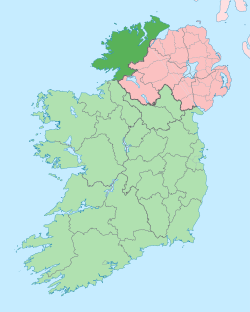Ballintra
Ballintra (Irish: Baile an tSratha) is a village in the parish of Drumholm in the south of County Donegal, Ireland, just off the N15 between Donegal town and Ballyshannon. Ballintra lies on the northern bank of the Blackwater river. (The river is sometimes referred to as Ballintra River).[2] The river rises in the hills that lie inland from the town, and flows through a number of small lakes before spilling over a small waterfall in a gorge behind the village.
Ballintra Baile an tSratha | |
|---|---|
Village | |
 Ballintra Location in Ireland | |
| Coordinates: 54°34′30″N 8°07′24″W | |
| Country | Ireland |
| Province | Ulster |
| County | County Donegal |
| Population (2016)[1] | 191 |
| Time zone | UTC+0 (WET) |
| • Summer (DST) | UTC-1 (IST (WEST)) |
| Irish Grid Reference | G917700 |
The Irish meaning of Ballintra Baile an tSratha, means town by the low-lying land along a river, the village is situated close to Rossnowlagh and Murvagh beaches.
The village is situated in a limestone area, and there are a number of quarries in the area.[3]
Amenities
Ballintra has one public house, a grocery store, a takeaway, a hairdresser, two primary schools (St. Ernan's NS and The Robertson NS),[4] and three churches (Methodist, Church of Ireland, and Roman Catholic).[5][6][7]
Sport
The Ballintra Races is an annual horse race run on a field close to the nearby Murvagh beach.[8] Proceeds from the event go to support amenities in the area.[9]
The local G.A.A. club is called Naomh Bríd (club also includes Laghey).[10] And the local Soccer club is called Copany Rovers (club also includes Laghey).
Transport
Ballintra railway station opened on 21 September 1905, but finally closed on 1 January 1960.[11] The station was on the County Donegal Railways Joint Committee network.
History

Decline of the Irish language
The 1911 census records only a handful of people in Ballintra who were Irish speakers. In his paper "Irish Speaking in the Pre-famine Period", Dr. Garret Fitzgerald remarks that "near Ballintra the language seems to have disappeared by the time of the Famine. Around Ballyshannon it also seems to have been almost extinct".[12] As late as 1960 up to a few dozen native Irish speakers remained in Tamhnach a' Mhullaigh (Grassy upland). The Irish scholar and campaigner Máirtín Ó Cadhain visited the area in 1957 to record folklore stores in Irish from a family in the area.
Developments
In the 1970s Donegal County Council built a small number of social housing units just off the Main Street on the Forge Road. A number of phases followed in which an additional twenty houses were added. A further change was the bypass of the village in the early 1980s.
People
- Saint Assicus is buried in Ballymagroarty, Ballintra. He was St Patrick's blacksmith and was en route from Elphin to County Down when he died[13]
- Leonard Boyle, a Canadian scholar, was born in Ballintra[14]
- Matt Gallagher, Gaelic footballer, All-Ireland winner with Donegal in 1992, played with Laghey-Ballintra club Naomh Bríd[15]
- Thomas Morrow, who became a politician in New South Wales, was born in Ballintra[16]
- David Walsh, inter-county Gaelic footballer, is a native of Ballintra[17]
See also
- List of populated places in Ireland
- List of abbeys and priories in Ireland (County Donegal)
References
- "Census 2016 Sapmap Area: Settlements Ballintra". Central Statistics Office (Ireland). Retrieved 4 June 2018.
- "Abhainn Bhaile an tSratha / Ballintra River". Logainm.ie. Irish Placenames Commission. Retrieved 26 October 2018.
- "Report on Ballintra cSAC (candidate Special Area of Conservation)" (PDF). npws.ie. National Parks and Wildlife Service. 2006. Retrieved 26 October 2018.
- "Robertson National School website". robertson.ie. Robertson NS. Retrieved 26 October 2018.
- "Ballintra Methodist Church". buildingsofireland.ie. National Inventory of Architectural Heritage. Retrieved 26 October 2018.
- "Ballintra Church of Ireland". buildingsofireland.ie. National Inventory of Architectural Heritage. Retrieved 26 October 2018.
- "St. Bridget's Catholic Church". buildingsofireland.ie. National Inventory of Architectural Heritage. Retrieved 26 October 2018.
- "Fantastic day of racing on the cards at the Ballintra Races". donegaldemocrat.ie. Donegal Democrat. 6 August 2017. Retrieved 26 October 2018.
- "Ballintra / Laghey Notes". donegaldemocrat.ie. Donegal Democrat. 23 July 2009. Archived from the original on 1 August 2012.
- "Naomh Bríd Club Location". naomhbrid.ie. Naomh Bríd GAA Club. Archived from the original on 16 September 2018. Retrieved 26 October 2018.
- "Ballintra station" (PDF). Railscot - Irish Railways. Archived (PDF) from the original on 26 September 2007. Retrieved 10 September 2007.
- Fitzgerald, Garret (2003). "Irish-Speaking in the Pre-Famine Period: A Study Based on the 1911 Census Data for People Born before 1851 and Still Alive in 1911". Proceedings of the Royal Irish Academy: Archaeology, Culture, History, Literature. 103C (5): 191–283. JSTOR 25506198.
- "St Asicus". elphindiocese.ie. Elphin Diocese. Retrieved 26 October 2018.
- "Obituary: The Rev Leonard Boyle". The Independent. 2 November 1999. Retrieved 26 October 2018.
- "Gallagher, Matt". hoganstand.com. Hogan Stand. 17 July 1992. Retrieved 20 February 2019.
- "Mr Thomas Howard Morrow (1888-1971)". Former Members of the Parliament of New South Wales. Retrieved 23 June 2019.
- "Donegal Players Profile". The Kerryman. Independent News & Media. 17 September 2014 – via pressreader.com.
David Walsh [,] The Ballintra native, who was once on Luton Town's books, first appeared for Donegal as a 25-year-old
